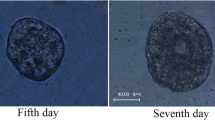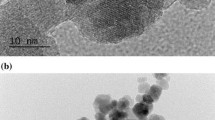Abstract
Due to biocompatibility and relative non-toxic nature, gold nanoparticles (GNPs) have been studied widely to be employed in radiotherapy as radio-sensitizer. On the other hand, they may enhance radiation-induced bystander effect (RIBE), which causes radiation adverse effects in non-irradiated normal cells. The present study was planned to investigate the possibility of augmenting the RIBE consequence of applying glucose-coated gold nanoparticles (Glu-GNPs) to target cells. Glu-GNPs were synthesized and utilized to treat MCF7 and QUDB cells. The treated cells were irradiated with 100 kVp X-rays, and their culture media were transferred to non-irradiated bystander cells. Performing MTT cellular proliferation test and colony formation assay, percentage cell viability and survival fraction of bystander cells were determined, respectively, and were compared to control bystander cells which received culture medium from irradiated cells without Glu-GNPs. Glu-GNPs decreased the cell viability and survival fraction of QUDB bystander cells by as much as 13.2 and 11.5 %, respectively (P < 0.02). However, the same end points were not changed by Glu-GNPs in MCF-7 bystander cells. Different RIBE responses were observed in QUDB and MCF7 loaded with Glu-GNPs. Glu-GNPs increased the RIBE in QUDB cells, while they had no effects on RIBE in MCF7 cells. As opposed to QUDB cells, the RIBE in MCF7 cells did not change in the dose range of 0.5–10 Gy. Therefore, it might be a constant effect and the reason of not being increased by Glu-GNPs.




Similar content being viewed by others
References
Blyth BJ, Sykes PJ (2011) Radiation-induced bystander effects: what are they, and how relevant are they to human radiation exposures? Radiat Res 176:139–157
Chithrani BD, Ghazani AA, Chan WC (2006) Determining the size and shape dependence of gold nanoparticle uptake into mammalian cells. Nano Lett 6:662–668
Cho EC, Au L, Zhang Q, Xia Y (2010) The effects of size, shape, and surface functional group of gold nanostructures on their adsorption and internalization by cells. Small 6:517–522
Erkang J, Lijun W (2009) Caffeine markedly enhanced radiation-induced bystander effects. Plasma Sci Technol 11:250
Evans Jr H (1994) CRC Handbook of chemistry and physics, 75th edn. DR Lide CRC Press, Boston, Section 12:1
Geng F et al (2011) Thio-glucose bound gold nanoparticles enhance radio-cytotoxic targeting of ovarian cancer. Nanotechnology 22:285101
Kobayashi K, Usami N, Porcel E, Lacombe S, Le Sech C (2010) Enhancement of radiation effect by heavy elements. Mutat Res Rev Mutat Res 704:123–131
Kong T et al (2008) Enhancement of radiation cytotoxicity in breast-cancer cells by localized attachment of gold nanoparticles. Small 4:1537–1543
Malugin A, Ghandehari H (2010) Cellular uptake and toxicity of gold nanoparticles in prostate cancer cells: a comparative study of rods and spheres. J Appl Toxicol 30:212–217
Mancuso M, Pasquali E, Giardullo P, Leonardi S, Tanori M, Di Majo V, Pazzaglia S, Saran A (2012) The radiation bystander effect and its potential implications for human health. Curr Mol Med 12:613–662
Mothersill C, Seymour C (2013) Uncomfortable issues in radiation protection posed by low-dose radiobiology. Radiat Environ Biophys 52:293–298
Mothersill C, Moriarty M, Seymour C (2004) Radiotherapy and the potential exploitation of bystander effects. Int J Radiat Oncol Biol Phys 58:575–579
Shao C, Folkard M, Held KD, Prise KM (2008) Estrogen enhanced cell-cell signalling in breast cancer cells exposed to targeted irradiation. BMC Cancer 8:184
Soleymanifard S, Toossi MTB, Sazgarnia A, Mohebbi S (2013) The role of target and bystander cells in dose-response relationship of radiation-induced bystander effects in two cell lines. Iran J Basic Med Sci 16:177
Trono JD, Mizuno K, Yusa N, Matsukawa T, Yokoyama K, Uesaka M (2011) Size, concentration and incubation time dependence of gold nanoparticle uptake into pancreas cancer cells and its future application to X-ray drug delivery system. J Radiat Res 52:103–109
Veldwijk MR, Zhang B, Wenz F, Herskind C (2014) The biological effect of large single doses: a possible role for non-targeted effects in cell inactivation. PloS ONE 9:e84991
Wang H, Boecker W, Wang H, Wang X, Guan J, Thompson L, Nickoloff J, Iliakis G (2004) Caffein inhibits homology-directed repair of I-SceI-induced DNA double-strand breaks. Oncogene 23:824–834
Wang C, Li X, Wang Y, Liu Z, Fu L, Hu L (2013) Enhancement of radiation effect and increase of apoptosis in lung cancer cells by thio-glucose-bound gold nanoparticles at megavoltage radiation energies. J Nanopart Res 15:1–12
Wang C, Jiang Y, Li X, Hu L (2015) Thioglucose-bound gold nanoparticles increase the radiosensitivity of a triple-negative breast cancer cell line (MDA-MB-231). Breast Cancer 22(4):413–420
Zhang X et al (2008) Enhanced radiation sensitivity in prostate cancer by gold-nanoparticles. Clin Invest Med 31:160–167
Zhang X-D, Wu D, Shen X, Chen J, Sun Y-M, Liu P-X, Liang X-J (2012) Size-dependent radiosensitization of PEG-coated gold nanoparticles for cancer radiation therapy. Biomaterials 33:6408–6419
Acknowledgments
The authors thank the office of Vice-President for Research of Mashhad University of Medical Sciences (MUMS) for funding this work. The authors are also grateful to Dr. Neda Attaran-Kakhki for kind cooperation in this research. This article is based on the results extracted from an M.Sc. thesis (Code No: 911095) presented to the medical physics department of MUMS.
Author information
Authors and Affiliations
Corresponding author
Rights and permissions
About this article
Cite this article
Rostami, A., Toossi, M.T.B., Sazgarnia, A. et al. The effect of glucose-coated gold nanoparticles on radiation bystander effect induced in MCF-7 and QUDB cell lines. Radiat Environ Biophys 55, 461–466 (2016). https://doi.org/10.1007/s00411-016-0669-y
Received:
Accepted:
Published:
Issue Date:
DOI: https://doi.org/10.1007/s00411-016-0669-y




